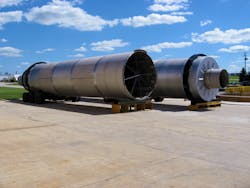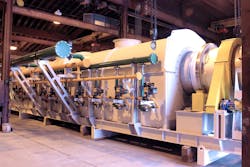Relying on rotary drums for process heating and cooling
Heating and cooling are fundamental aspects of processing industrial minerals and chemicals into market-ready products and materials.
While the available technologies for drying, heating and cooling bulk solids can make deciding on a given approach challenging, processors often come to rely on rotary drum technology for the many benefits it can offer.
The following provides an overview on how these machines are used to carry out various processing objectives, and why many plant managers prefer them over other technologies.
Rotary drum fundamentals
Rotary drums are incredibly versatile in their ability to process materials. From scrubbing ores to coating fertilizer products, these drums can accomplish a number of process objectives. They also offer significant opportunity for customizing the drum around the specific demands of the intended application. No matter what they are tasked with accomplishing, however, they all rely on the same basic technology: a rotating drum.
The rotary drum consists of a large, rotating cylinder resting on a stationary base and situated between housings on each end that connect the drum to the surrounding process. The stationary base is in part made up of a drive assembly, which powers the unit to allow rotation on the base.
Material is fed into one end of the drum, which is set on a slight angle so gravity can assist in moving material through the drum, while also achieving the desired retention time. Material tumbles through the drum and is exposed to the processing medium (heat, binder, liquid additives, chilled air, etc.) to reach the desired objective, at which point it discharges from the drum and moves on to downstream processing.
When it comes specifically to drying, cooling and heating material, rotary drums are customized as follows:
Drying (rotary dryers)
Rotary drums used for drying are referred to as rotary dryers. They may be employed as a pre-production step, helping to prepare material for subsequent processing, or as a post-production step, finishing material into its final dried form. They are widely used in the processing and production of minerals, fertilizers, aggregates, process by-products, pulp and paper residuals, salts, sugars and more.
These machines reduce the moisture content of bulk solids by heating the material, either directly (via convection) with products of combustion, or indirectly (via radiant heat), through an externally heated furnace or heat shroud.
Direct rotary dryers are the most common approach of the two, as they are by far the most efficient. In the direct type, combustion gases are directed through the rotary drum, either in the same direction as the material (parallel or co-current flow) or in the opposite direction (counter-current flow). The choice between the two air flow options depends on the material characteristics.
Flights, or material lifters, pick up material and cascade it through the hot air (gas) stream to maximize heat transfer. A combustion chamber may or may not be affixed to the unit, depending on process goals and the sensitivity of the material.
In an indirectly heated unit, the drum is sealed off from the external environment. The surrounding shroud is heated, which heats the drum shell, and ultimately the material, via direct contact. Tumbling flights or bed disturbers may be employed to encourage agitation and uniform exposure of the material to the drum shell. This approach, though less efficient, is often used when a fine particle size risks entrainment, or when an inert processing atmosphere is necessary.
Cooling (rotary coolers)
Rotary drums utilized for cooling are referred to as rotary coolers. Rotary coolers are used to reduce the temperature of incoming material or product so that it can be handled without risk to downstream employees or equipment. Cooling also helps to prevent caking and discourage mold or bacterial growth in the product during transport, storage or shelf life. Rotary coolers are frequently employed as a finishing step in fertilizer production.
Rotary coolers operate on the same principle as rotary dryers, the only difference being that instead of heat, a cooling medium is used. Like rotary dryers, rotary coolers can be configured for direct or indirect cooling.
Most rotary coolers are direct, as this is the most efficient approach. In this case, material is fed into the unit counter-currently in relation to the stream of chilled air for maximum efficiency. Flights pick up material and drop it through the air stream to maximize heat transfer.
In the case of an indirect cooler, the drum is bathed in chilled water to cool the drum shell. This in turn cools the material in contact with the shell. Here again, tumbling flights can be added to improve bed turnover and agitation.
Heating (rotary kilns)
Rotary kilns are not that different from rotary dryers; the difference is that they typically operate at much higher temperatures, as they are intended to cause a physical change or chemical reaction in the material being processed. As such, their applications are diverse, falling under specialty chemicals, mineral concentrates, roofing granules, process by-products and industrial wastes, adsorbents, technical ceramics and more.
Rotary kilns can also be designed in either a direct or indirect configuration. Again, a combustion chamber, as well as lifting or tumbling flights, may be incorporated depending on whether the unit is of the direct or indirect design and whether or not the material being processed is sensitive to flame. In the case of indirect units, purge gases may also be incorporated to achieve a specific processing atmosphere inside the kiln.
Benefits of utilizing rotary drums for process heating and cooling
Rotary drum technology offers several benefits in a process setting and as such, has become a favored approach to processing in a number of industries ranging from chemicals to minerals, and everything in between. Rotary drums are often recognized for the following advantages:
High throughput
Rotary drums typically offer the highest processing capacity of any type of equipment, making them the equipment of choice in high-throughput operations.
Easy to use
Rotary drums are based on simple technology. Whether they are drying, cooling, heating or otherwise, they are generally simple to operate and maintain. Minimal adjustment is required while in operation and few things can go wrong. This translates to a low supervision requirement.
Established and supported technology
Rotary drums have been used in industry for nearly as long as industry has been around. This makes them well-established and supported as a technology. In other words, there are numerous suppliers and service providers available to assist in replacing, upgrading and maintaining them. Likewise, there is little mystery left to the technology and few issues to work out.
Robust design and build
Rotary drums are recognized as a heavy-duty processing option, capable of withstanding harsh production environments and demanding operating conditions. For this reason, they are a favored approach to processing in the mining industry.
Extremely reliable
In part due to their robust build and simple operation, rotary drums have developed a well-deserved reputation as industry workhorses, often providing decades of reliable, trouble-free processing when properly maintained.
Largely insensitive
While a uniform feedstock always yields the best result, rotary drums are largely insensitive to small fluctuations in feedstock conditions such as moisture content, particle size distribution and feed rate.
Tumbling action
The tumbling action that occurs in the material bed of any rotary drum, whether it is used for drying, cooling or otherwise, is often advantageous to the product.
This is because the tumbling not only helps to agitate the bed, which increases distribution of any added components (such as a liquid coating), but it also can help to polish granular materials, rounding any rough edges and yielding a more refined product.
Efficient
While the efficiency of a given rotary drum is highly dependent on its design and build, in general, rotary drums offer significant potential for the drum design to be customized in a way that maximizes efficiency for the objective at hand. This includes options in length and diameter, air volume, seals, internals and additional components such as refractory, trommel screens, knocking systems and more.
Facilities such as the FEECO Innovation Center are also available for conducting pilot-scale trials for optimizing drum design for the intended application. While testing is not typically conducted for cooling operations, it is widely used in developing optimized commercial-scale equipment for drying, coating, granulation, polishing and even high-temperature processing operations such as calcination, metal recovery, activation and more.
One technology, many options
The other benefit to rotary drums is that their flexibility allows plant managers to utilize a single technology throughout the plant. This in itself has several advantages:
- Simplified maintenance requirements
- Streamlined and interchangeable spare parts inventory
- Simplified operator training
The use of multiple drums to carry out various processes is not uncommon. In the fertilizer industry, for example, rotary drums can be found throughout production plants, carrying out granulation, drying, cooling and coating. A similar occurrence is found in the production of roofing granules, where plants can use rotary drums for drying, pre-heating, coloring and curing granules.
Conclusion
While heating and cooling require different approaches to processing bulk solids, both objectives, along with many more, can be met with the diversity of rotary drum technology.
Rotary drums offer numerous benefits in a process setting, not the least of which is their robust build, reliability and high throughput. They also allow plant managers to streamline operations by utilizing a single technology to carry out several objectives in a production plant.
Shane Le Capitaine is a process sales engineer at FEECO International, where he specializes in bulk solids drying, fertilizer granulation, and rotary drum applications. Capitaine received a B.S. in chemical engineering from the University of Wisconsin-Madison and has decades of experience in his field.
Carrie Carlson is a technical writer who has been with FEECO for over a decade. She works closely with engineers and process experts to turn complex ideas into easy-to-understand literature.
FEECO International
About the Author
Carrie Carlson
Technical Writer, FEECO
Carrie Carlson is a technical writer who has been with FEECO for over a decade. She works closely with engineers and process experts to turn complex ideas into easy-to-understand literature.




